Development of the Rohingya Problem and its Impact on Bangladesh
VerifiedAdded on 2020/03/16
|30
|7562
|48
Report
AI Summary
This report provides a comprehensive analysis of the Rohingya problem, focusing on its development, the issues faced by Bangladesh, and potential mitigation strategies. The introduction outlines the ethnic tensions in Myanmar, particularly in the Rakhine state, leading to a mass exodus of Rohingya refugees into neighboring countries, especially Bangladesh. The study examines the background of the crisis, highlighting the oppression faced by the Rohingya population and the role of the Arakan Rohingya Salvation Army (ARSA). The research aims to analyze the current situation, identify the issues arising from the problem, and recommend solutions. The literature review discusses the denial of citizenship, religious differences, and political tensions. It also delves into the specific challenges faced by Bangladesh, including human security threats, health issues, and internal/transnational security concerns. The methodology outlines the research approach, design, data collection procedures, sampling techniques, and limitations. The data analysis explores the causes of the problem, the issues faced by Bangladesh, and potential mitigation strategies, which are then linked back to the objectives of the research. Finally, the report concludes with recommendations to address the complex challenges posed by the Rohingya crisis.
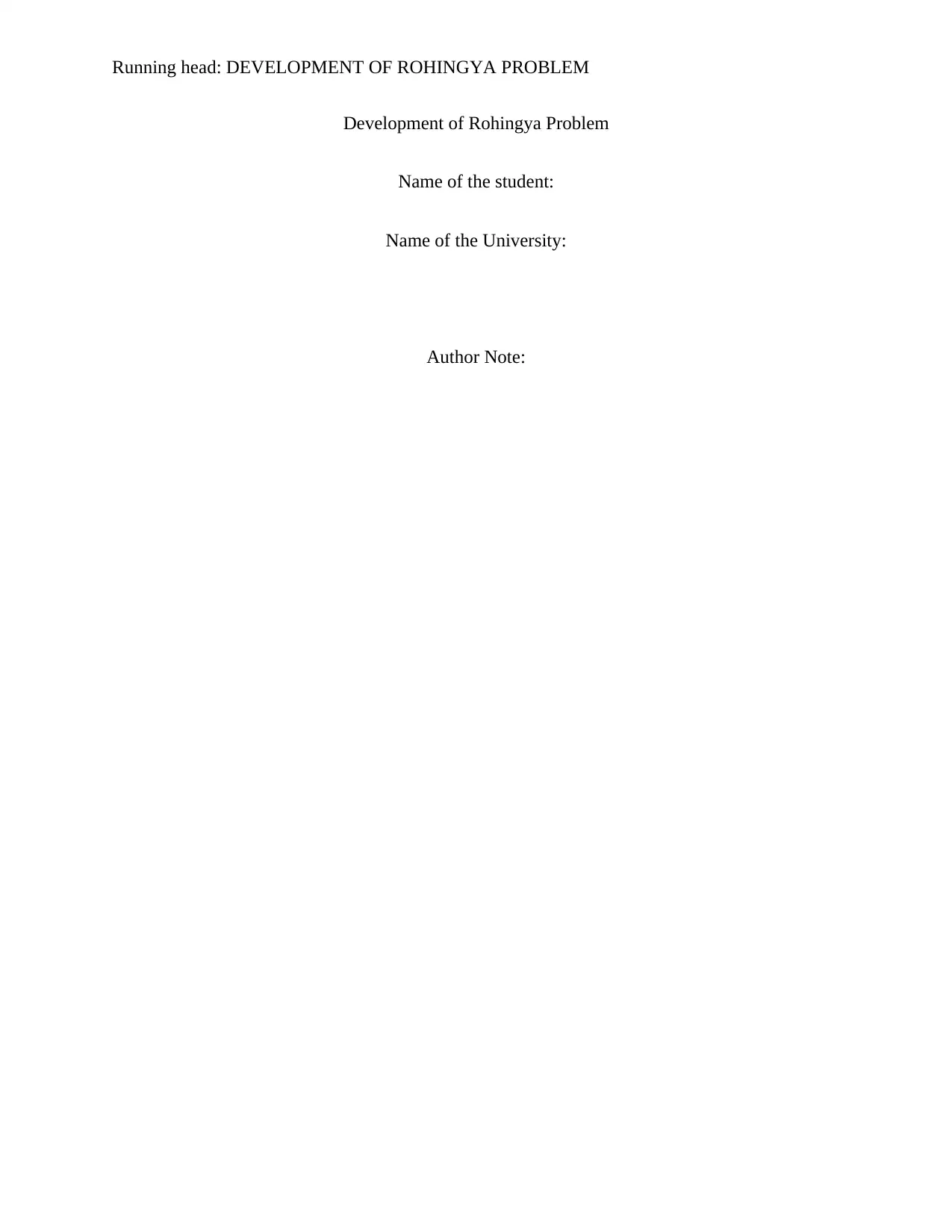
Running head: DEVELOPMENT OF ROHINGYA PROBLEM
Development of Rohingya Problem
Name of the student:
Name of the University:
Author Note:
Development of Rohingya Problem
Name of the student:
Name of the University:
Author Note:
Paraphrase This Document
Need a fresh take? Get an instant paraphrase of this document with our AI Paraphraser
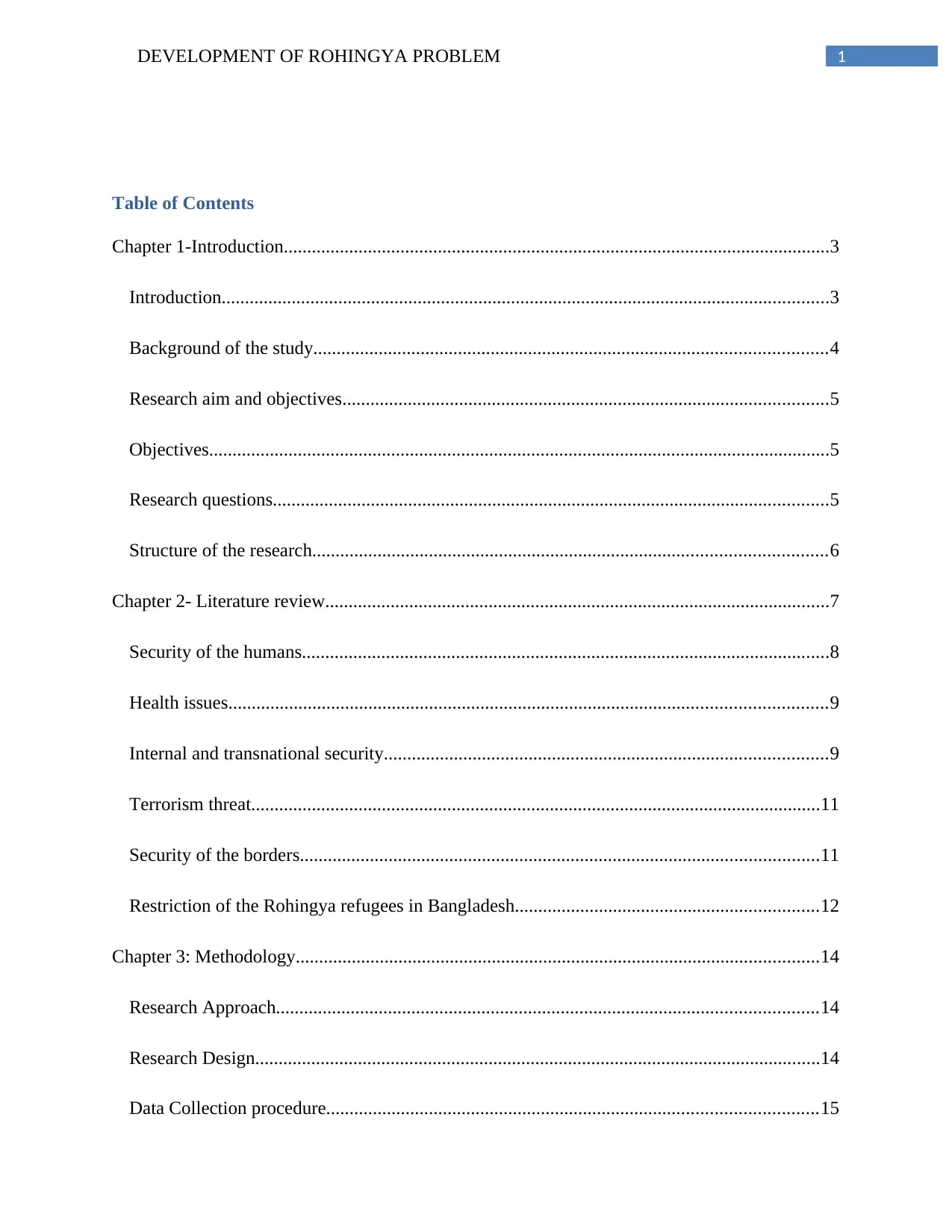
1DEVELOPMENT OF ROHINGYA PROBLEM
Table of Contents
Chapter 1-Introduction.....................................................................................................................3
Introduction..................................................................................................................................3
Background of the study..............................................................................................................4
Research aim and objectives........................................................................................................5
Objectives.....................................................................................................................................5
Research questions.......................................................................................................................5
Structure of the research..............................................................................................................6
Chapter 2- Literature review............................................................................................................7
Security of the humans.................................................................................................................8
Health issues................................................................................................................................9
Internal and transnational security...............................................................................................9
Terrorism threat..........................................................................................................................11
Security of the borders...............................................................................................................11
Restriction of the Rohingya refugees in Bangladesh.................................................................12
Chapter 3: Methodology................................................................................................................14
Research Approach....................................................................................................................14
Research Design.........................................................................................................................14
Data Collection procedure.........................................................................................................15
Table of Contents
Chapter 1-Introduction.....................................................................................................................3
Introduction..................................................................................................................................3
Background of the study..............................................................................................................4
Research aim and objectives........................................................................................................5
Objectives.....................................................................................................................................5
Research questions.......................................................................................................................5
Structure of the research..............................................................................................................6
Chapter 2- Literature review............................................................................................................7
Security of the humans.................................................................................................................8
Health issues................................................................................................................................9
Internal and transnational security...............................................................................................9
Terrorism threat..........................................................................................................................11
Security of the borders...............................................................................................................11
Restriction of the Rohingya refugees in Bangladesh.................................................................12
Chapter 3: Methodology................................................................................................................14
Research Approach....................................................................................................................14
Research Design.........................................................................................................................14
Data Collection procedure.........................................................................................................15
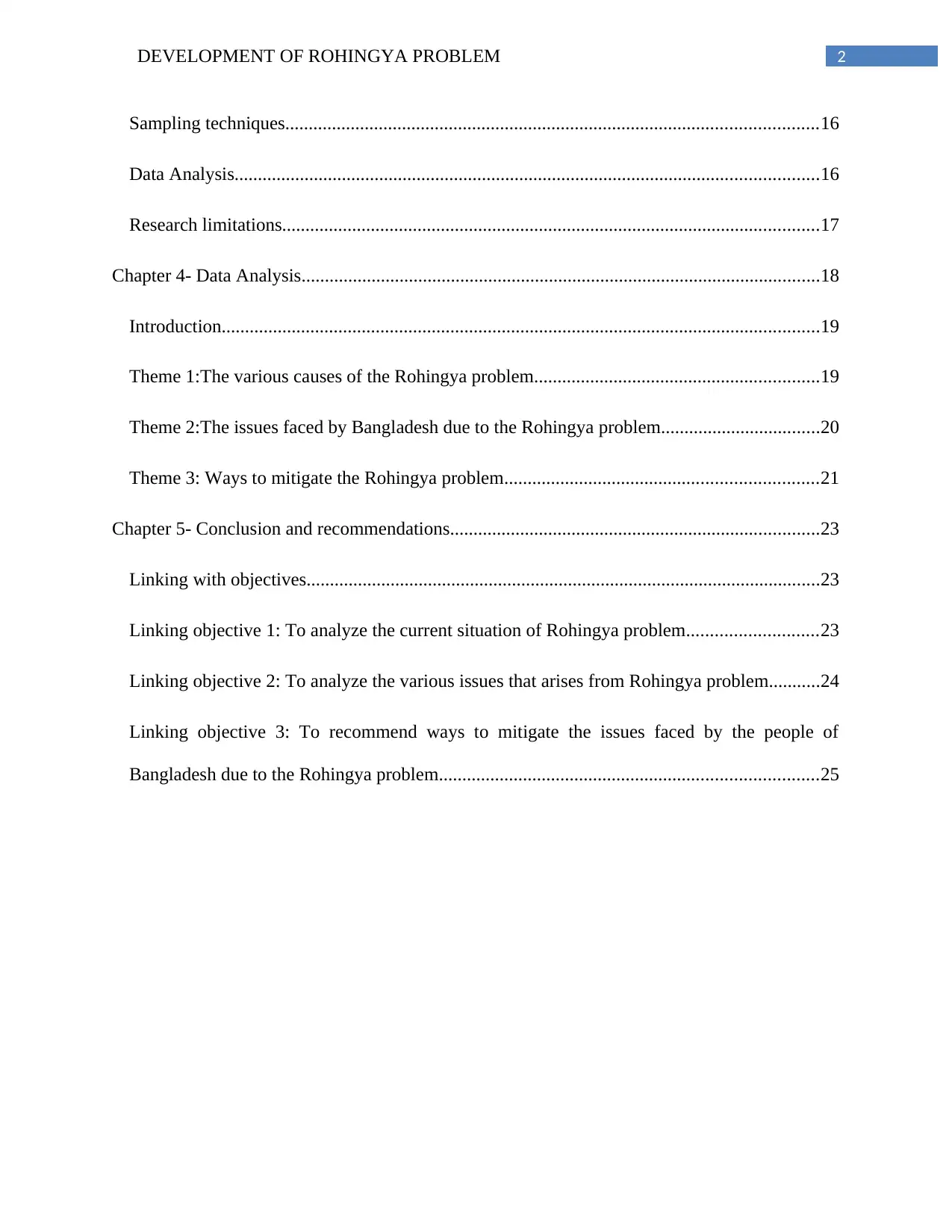
2DEVELOPMENT OF ROHINGYA PROBLEM
Sampling techniques..................................................................................................................16
Data Analysis.............................................................................................................................16
Research limitations...................................................................................................................17
Chapter 4- Data Analysis...............................................................................................................18
Introduction................................................................................................................................19
Theme 1:The various causes of the Rohingya problem.............................................................19
Theme 2:The issues faced by Bangladesh due to the Rohingya problem..................................20
Theme 3: Ways to mitigate the Rohingya problem...................................................................21
Chapter 5- Conclusion and recommendations...............................................................................23
Linking with objectives..............................................................................................................23
Linking objective 1: To analyze the current situation of Rohingya problem............................23
Linking objective 2: To analyze the various issues that arises from Rohingya problem...........24
Linking objective 3: To recommend ways to mitigate the issues faced by the people of
Bangladesh due to the Rohingya problem.................................................................................25
Sampling techniques..................................................................................................................16
Data Analysis.............................................................................................................................16
Research limitations...................................................................................................................17
Chapter 4- Data Analysis...............................................................................................................18
Introduction................................................................................................................................19
Theme 1:The various causes of the Rohingya problem.............................................................19
Theme 2:The issues faced by Bangladesh due to the Rohingya problem..................................20
Theme 3: Ways to mitigate the Rohingya problem...................................................................21
Chapter 5- Conclusion and recommendations...............................................................................23
Linking with objectives..............................................................................................................23
Linking objective 1: To analyze the current situation of Rohingya problem............................23
Linking objective 2: To analyze the various issues that arises from Rohingya problem...........24
Linking objective 3: To recommend ways to mitigate the issues faced by the people of
Bangladesh due to the Rohingya problem.................................................................................25
⊘ This is a preview!⊘
Do you want full access?
Subscribe today to unlock all pages.

Trusted by 1+ million students worldwide
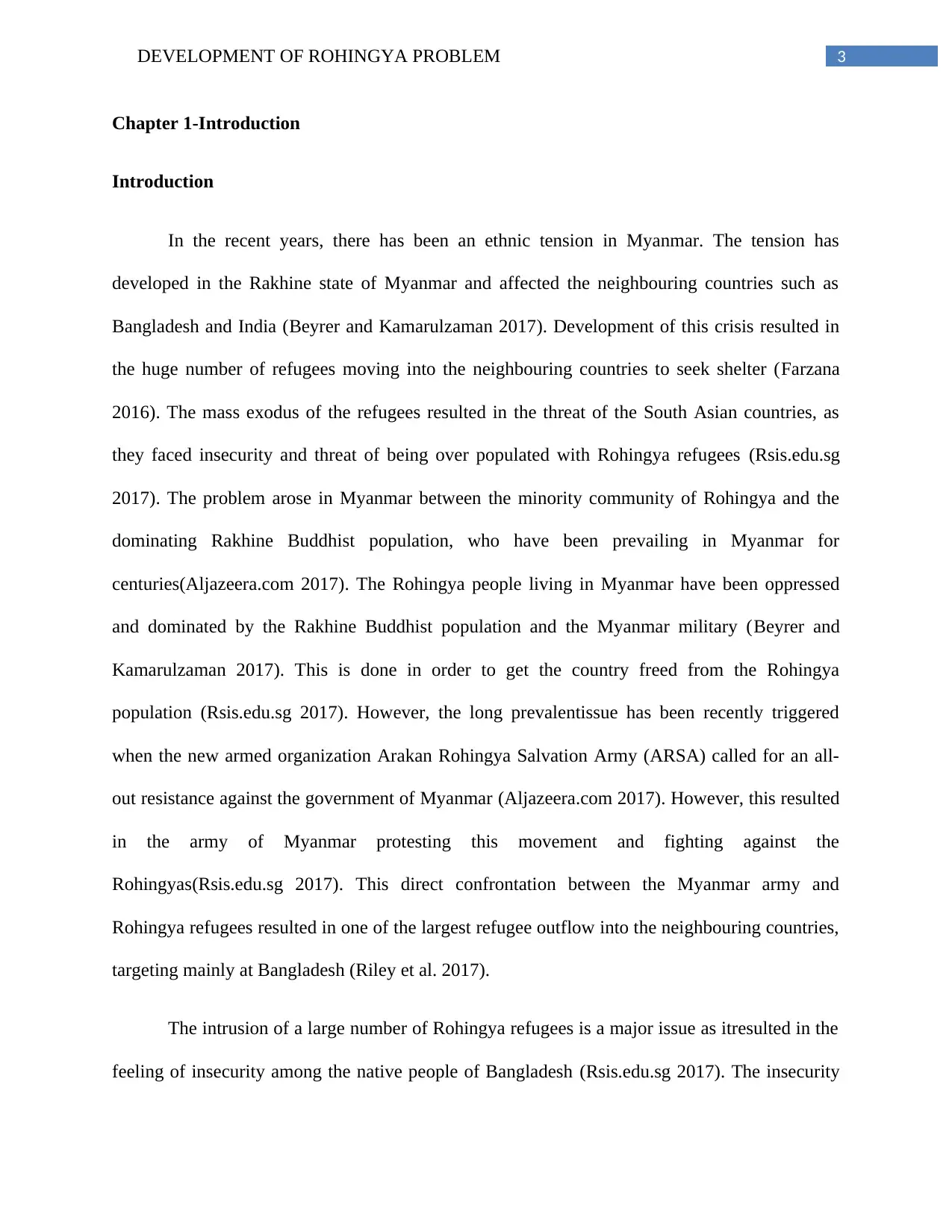
3DEVELOPMENT OF ROHINGYA PROBLEM
Chapter 1-Introduction
Introduction
In the recent years, there has been an ethnic tension in Myanmar. The tension has
developed in the Rakhine state of Myanmar and affected the neighbouring countries such as
Bangladesh and India (Beyrer and Kamarulzaman 2017). Development of this crisis resulted in
the huge number of refugees moving into the neighbouring countries to seek shelter (Farzana
2016). The mass exodus of the refugees resulted in the threat of the South Asian countries, as
they faced insecurity and threat of being over populated with Rohingya refugees (Rsis.edu.sg
2017). The problem arose in Myanmar between the minority community of Rohingya and the
dominating Rakhine Buddhist population, who have been prevailing in Myanmar for
centuries(Aljazeera.com 2017). The Rohingya people living in Myanmar have been oppressed
and dominated by the Rakhine Buddhist population and the Myanmar military (Beyrer and
Kamarulzaman 2017). This is done in order to get the country freed from the Rohingya
population (Rsis.edu.sg 2017). However, the long prevalentissue has been recently triggered
when the new armed organization Arakan Rohingya Salvation Army (ARSA) called for an all-
out resistance against the government of Myanmar (Aljazeera.com 2017). However, this resulted
in the army of Myanmar protesting this movement and fighting against the
Rohingyas(Rsis.edu.sg 2017). This direct confrontation between the Myanmar army and
Rohingya refugees resulted in one of the largest refugee outflow into the neighbouring countries,
targeting mainly at Bangladesh (Riley et al. 2017).
The intrusion of a large number of Rohingya refugees is a major issue as itresulted in the
feeling of insecurity among the native people of Bangladesh (Rsis.edu.sg 2017). The insecurity
Chapter 1-Introduction
Introduction
In the recent years, there has been an ethnic tension in Myanmar. The tension has
developed in the Rakhine state of Myanmar and affected the neighbouring countries such as
Bangladesh and India (Beyrer and Kamarulzaman 2017). Development of this crisis resulted in
the huge number of refugees moving into the neighbouring countries to seek shelter (Farzana
2016). The mass exodus of the refugees resulted in the threat of the South Asian countries, as
they faced insecurity and threat of being over populated with Rohingya refugees (Rsis.edu.sg
2017). The problem arose in Myanmar between the minority community of Rohingya and the
dominating Rakhine Buddhist population, who have been prevailing in Myanmar for
centuries(Aljazeera.com 2017). The Rohingya people living in Myanmar have been oppressed
and dominated by the Rakhine Buddhist population and the Myanmar military (Beyrer and
Kamarulzaman 2017). This is done in order to get the country freed from the Rohingya
population (Rsis.edu.sg 2017). However, the long prevalentissue has been recently triggered
when the new armed organization Arakan Rohingya Salvation Army (ARSA) called for an all-
out resistance against the government of Myanmar (Aljazeera.com 2017). However, this resulted
in the army of Myanmar protesting this movement and fighting against the
Rohingyas(Rsis.edu.sg 2017). This direct confrontation between the Myanmar army and
Rohingya refugees resulted in one of the largest refugee outflow into the neighbouring countries,
targeting mainly at Bangladesh (Riley et al. 2017).
The intrusion of a large number of Rohingya refugees is a major issue as itresulted in the
feeling of insecurity among the native people of Bangladesh (Rsis.edu.sg 2017). The insecurity
Paraphrase This Document
Need a fresh take? Get an instant paraphrase of this document with our AI Paraphraser
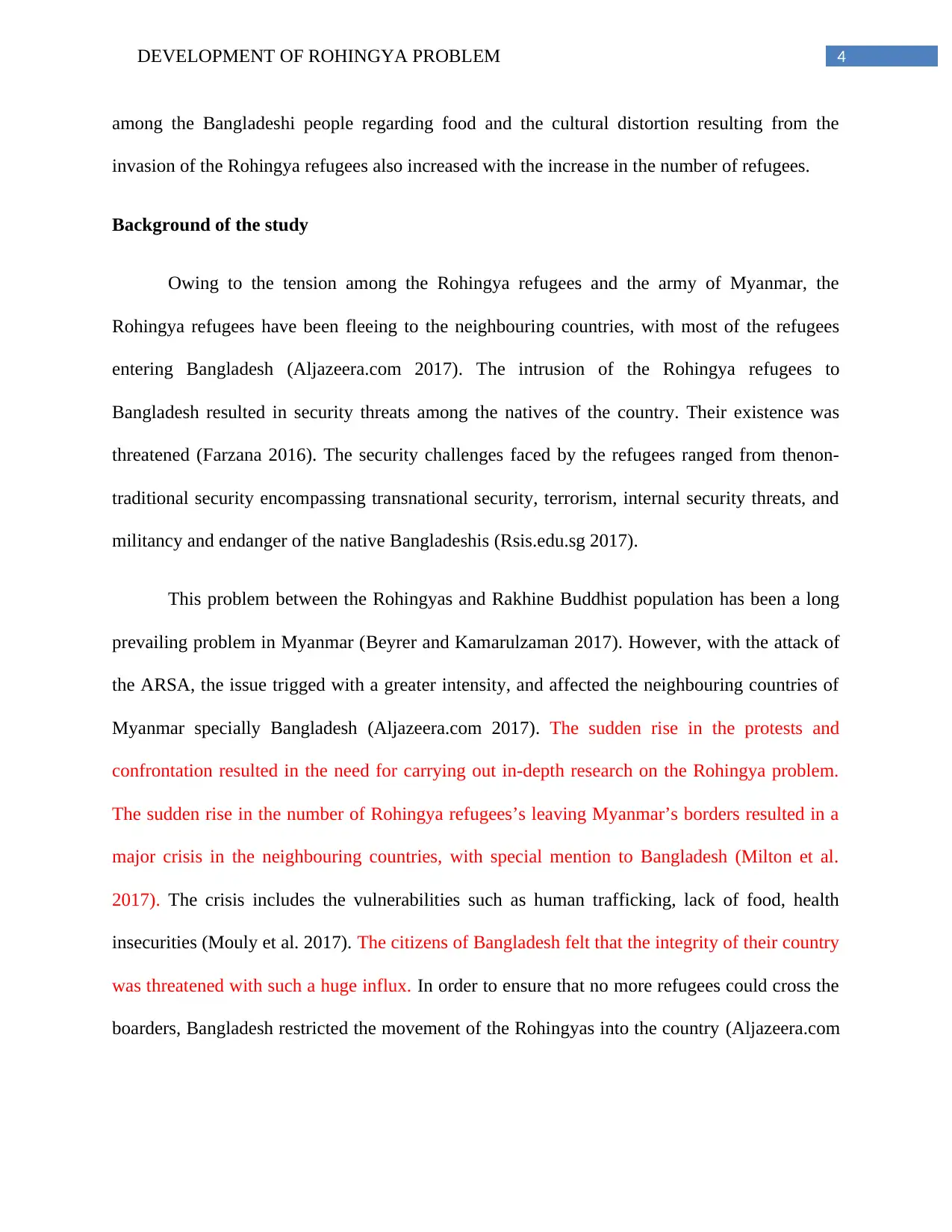
4DEVELOPMENT OF ROHINGYA PROBLEM
among the Bangladeshi people regarding food and the cultural distortion resulting from the
invasion of the Rohingya refugees also increased with the increase in the number of refugees.
Background of the study
Owing to the tension among the Rohingya refugees and the army of Myanmar, the
Rohingya refugees have been fleeing to the neighbouring countries, with most of the refugees
entering Bangladesh (Aljazeera.com 2017). The intrusion of the Rohingya refugees to
Bangladesh resulted in security threats among the natives of the country. Their existence was
threatened (Farzana 2016). The security challenges faced by the refugees ranged from thenon-
traditional security encompassing transnational security, terrorism, internal security threats, and
militancy and endanger of the native Bangladeshis (Rsis.edu.sg 2017).
This problem between the Rohingyas and Rakhine Buddhist population has been a long
prevailing problem in Myanmar (Beyrer and Kamarulzaman 2017). However, with the attack of
the ARSA, the issue trigged with a greater intensity, and affected the neighbouring countries of
Myanmar specially Bangladesh (Aljazeera.com 2017). The sudden rise in the protests and
confrontation resulted in the need for carrying out in-depth research on the Rohingya problem.
The sudden rise in the number of Rohingya refugees’s leaving Myanmar’s borders resulted in a
major crisis in the neighbouring countries, with special mention to Bangladesh (Milton et al.
2017). The crisis includes the vulnerabilities such as human trafficking, lack of food, health
insecurities (Mouly et al. 2017). The citizens of Bangladesh felt that the integrity of their country
was threatened with such a huge influx. In order to ensure that no more refugees could cross the
boarders, Bangladesh restricted the movement of the Rohingyas into the country (Aljazeera.com
among the Bangladeshi people regarding food and the cultural distortion resulting from the
invasion of the Rohingya refugees also increased with the increase in the number of refugees.
Background of the study
Owing to the tension among the Rohingya refugees and the army of Myanmar, the
Rohingya refugees have been fleeing to the neighbouring countries, with most of the refugees
entering Bangladesh (Aljazeera.com 2017). The intrusion of the Rohingya refugees to
Bangladesh resulted in security threats among the natives of the country. Their existence was
threatened (Farzana 2016). The security challenges faced by the refugees ranged from thenon-
traditional security encompassing transnational security, terrorism, internal security threats, and
militancy and endanger of the native Bangladeshis (Rsis.edu.sg 2017).
This problem between the Rohingyas and Rakhine Buddhist population has been a long
prevailing problem in Myanmar (Beyrer and Kamarulzaman 2017). However, with the attack of
the ARSA, the issue trigged with a greater intensity, and affected the neighbouring countries of
Myanmar specially Bangladesh (Aljazeera.com 2017). The sudden rise in the protests and
confrontation resulted in the need for carrying out in-depth research on the Rohingya problem.
The sudden rise in the number of Rohingya refugees’s leaving Myanmar’s borders resulted in a
major crisis in the neighbouring countries, with special mention to Bangladesh (Milton et al.
2017). The crisis includes the vulnerabilities such as human trafficking, lack of food, health
insecurities (Mouly et al. 2017). The citizens of Bangladesh felt that the integrity of their country
was threatened with such a huge influx. In order to ensure that no more refugees could cross the
boarders, Bangladesh restricted the movement of the Rohingyas into the country (Aljazeera.com
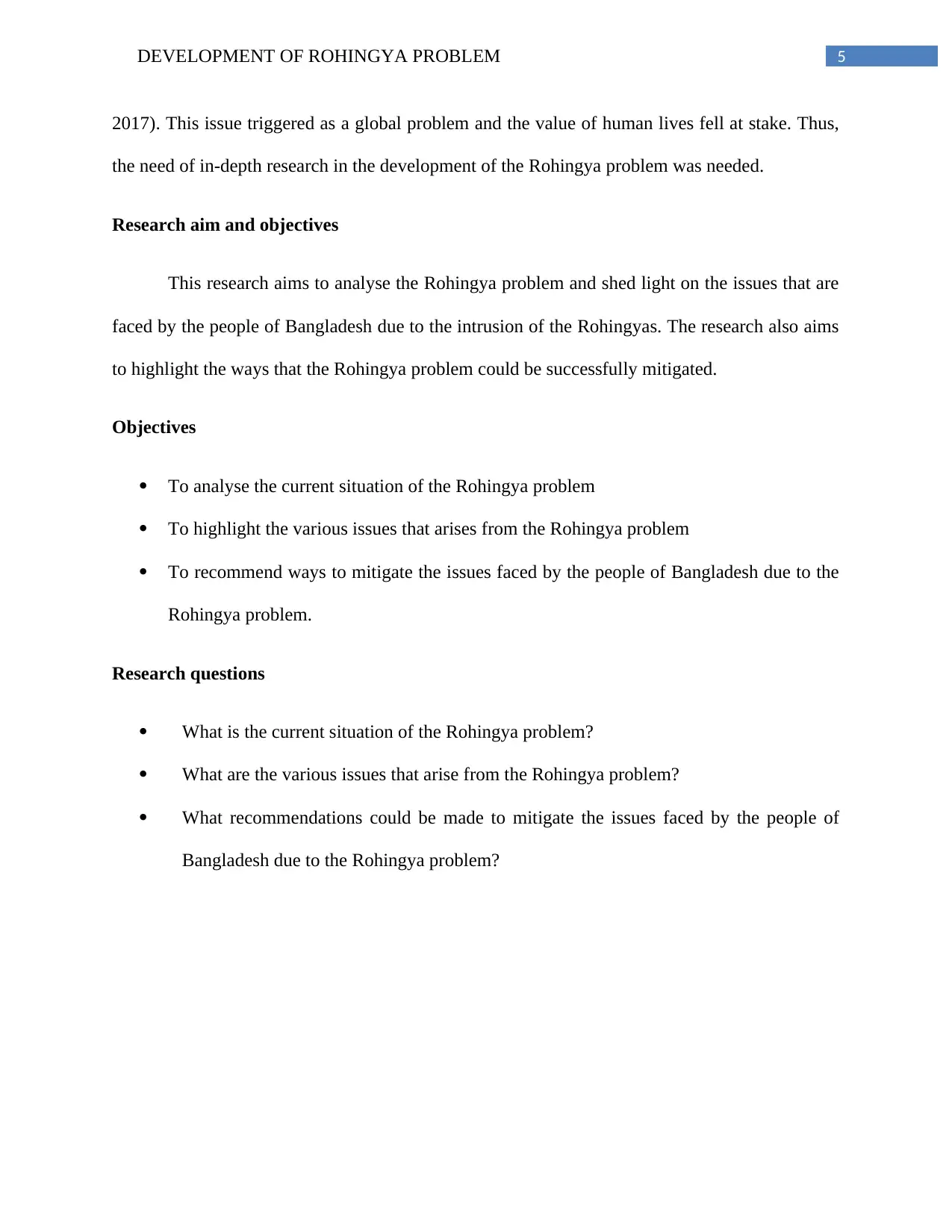
5DEVELOPMENT OF ROHINGYA PROBLEM
2017). This issue triggered as a global problem and the value of human lives fell at stake. Thus,
the need of in-depth research in the development of the Rohingya problem was needed.
Research aim and objectives
This research aims to analyse the Rohingya problem and shed light on the issues that are
faced by the people of Bangladesh due to the intrusion of the Rohingyas. The research also aims
to highlight the ways that the Rohingya problem could be successfully mitigated.
Objectives
To analyse the current situation of the Rohingya problem
To highlight the various issues that arises from the Rohingya problem
To recommend ways to mitigate the issues faced by the people of Bangladesh due to the
Rohingya problem.
Research questions
What is the current situation of the Rohingya problem?
What are the various issues that arise from the Rohingya problem?
What recommendations could be made to mitigate the issues faced by the people of
Bangladesh due to the Rohingya problem?
2017). This issue triggered as a global problem and the value of human lives fell at stake. Thus,
the need of in-depth research in the development of the Rohingya problem was needed.
Research aim and objectives
This research aims to analyse the Rohingya problem and shed light on the issues that are
faced by the people of Bangladesh due to the intrusion of the Rohingyas. The research also aims
to highlight the ways that the Rohingya problem could be successfully mitigated.
Objectives
To analyse the current situation of the Rohingya problem
To highlight the various issues that arises from the Rohingya problem
To recommend ways to mitigate the issues faced by the people of Bangladesh due to the
Rohingya problem.
Research questions
What is the current situation of the Rohingya problem?
What are the various issues that arise from the Rohingya problem?
What recommendations could be made to mitigate the issues faced by the people of
Bangladesh due to the Rohingya problem?
⊘ This is a preview!⊘
Do you want full access?
Subscribe today to unlock all pages.

Trusted by 1+ million students worldwide
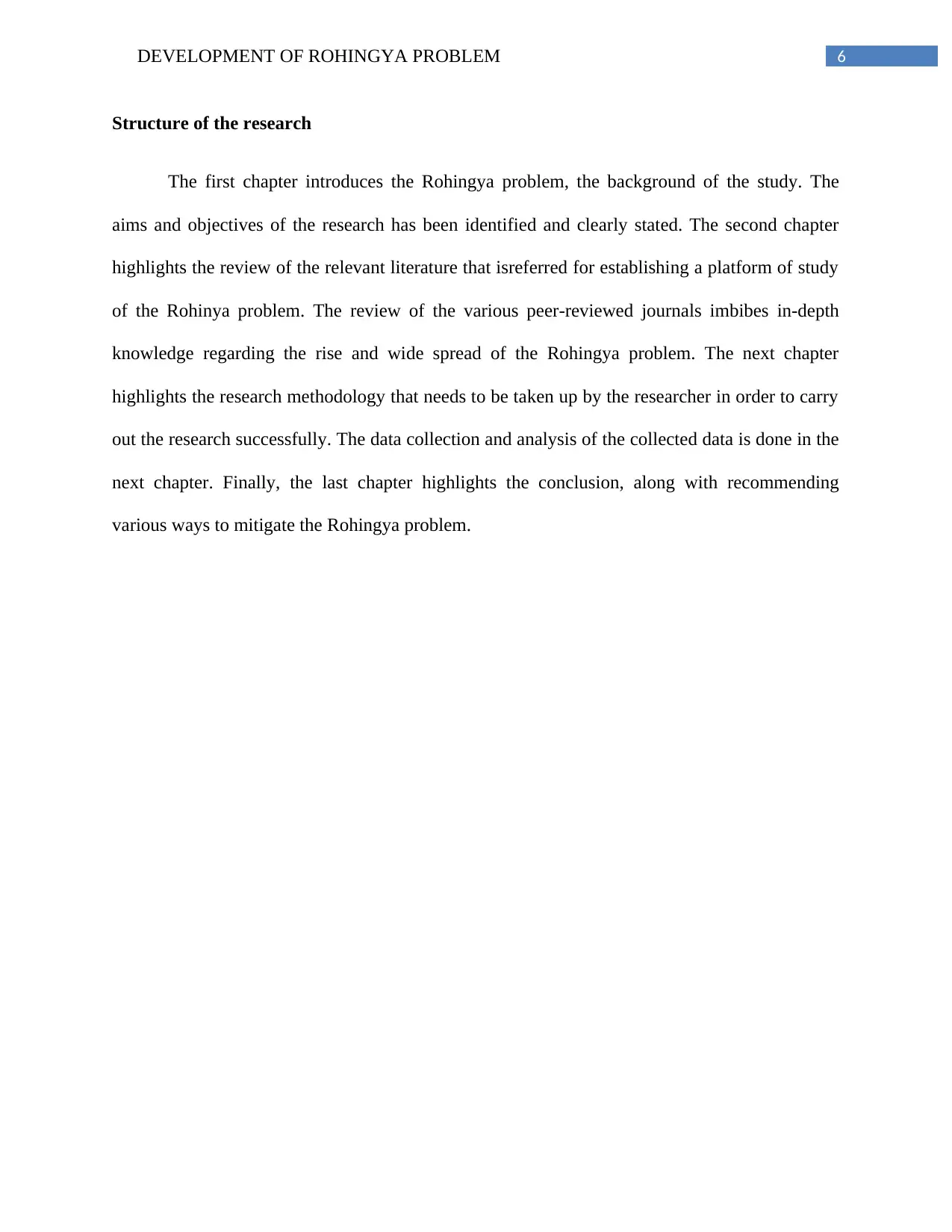
6DEVELOPMENT OF ROHINGYA PROBLEM
Structure of the research
The first chapter introduces the Rohingya problem, the background of the study. The
aims and objectives of the research has been identified and clearly stated. The second chapter
highlights the review of the relevant literature that isreferred for establishing a platform of study
of the Rohinya problem. The review of the various peer-reviewed journals imbibes in-depth
knowledge regarding the rise and wide spread of the Rohingya problem. The next chapter
highlights the research methodology that needs to be taken up by the researcher in order to carry
out the research successfully. The data collection and analysis of the collected data is done in the
next chapter. Finally, the last chapter highlights the conclusion, along with recommending
various ways to mitigate the Rohingya problem.
Structure of the research
The first chapter introduces the Rohingya problem, the background of the study. The
aims and objectives of the research has been identified and clearly stated. The second chapter
highlights the review of the relevant literature that isreferred for establishing a platform of study
of the Rohinya problem. The review of the various peer-reviewed journals imbibes in-depth
knowledge regarding the rise and wide spread of the Rohingya problem. The next chapter
highlights the research methodology that needs to be taken up by the researcher in order to carry
out the research successfully. The data collection and analysis of the collected data is done in the
next chapter. Finally, the last chapter highlights the conclusion, along with recommending
various ways to mitigate the Rohingya problem.
Paraphrase This Document
Need a fresh take? Get an instant paraphrase of this document with our AI Paraphraser
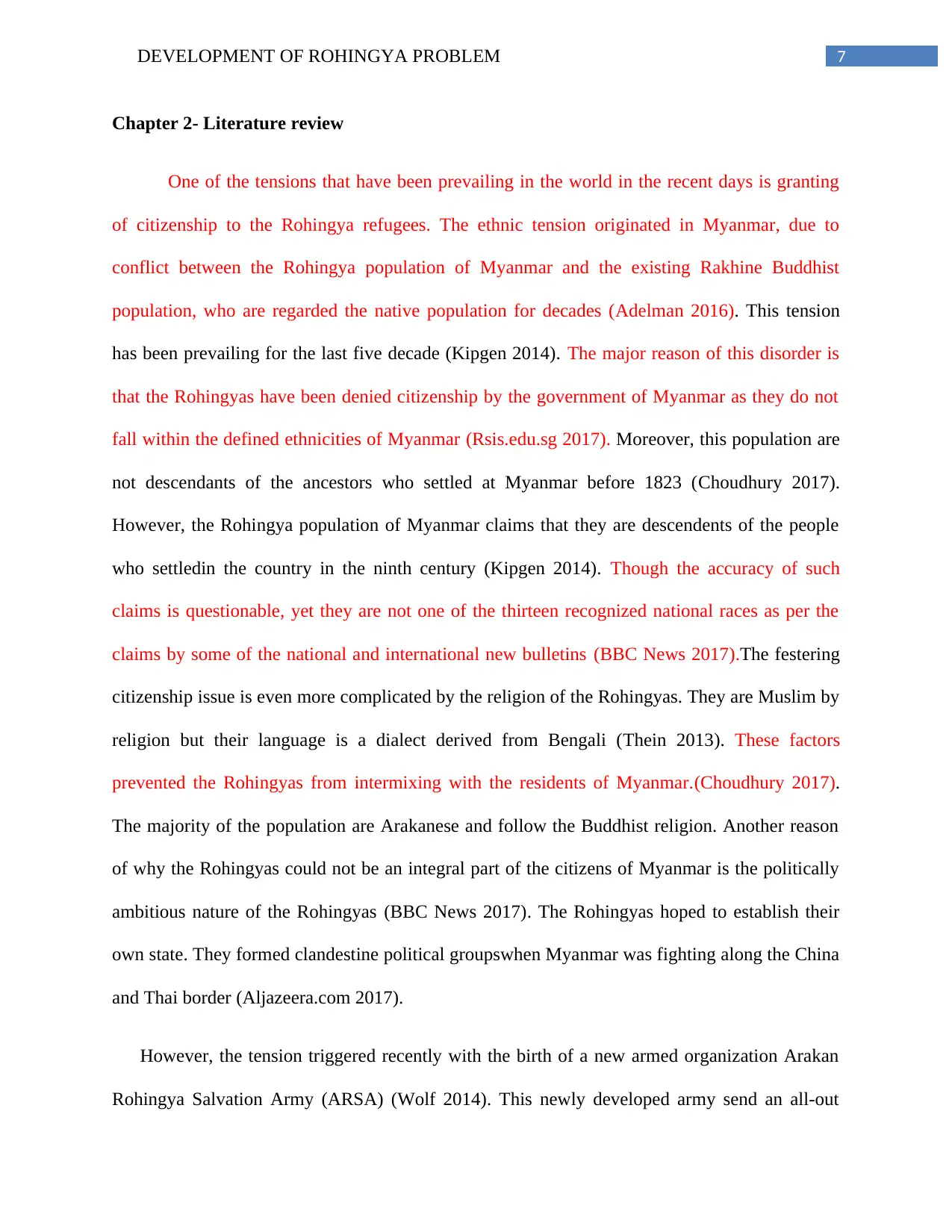
7DEVELOPMENT OF ROHINGYA PROBLEM
Chapter 2- Literature review
One of the tensions that have been prevailing in the world in the recent days is granting
of citizenship to the Rohingya refugees. The ethnic tension originated in Myanmar, due to
conflict between the Rohingya population of Myanmar and the existing Rakhine Buddhist
population, who are regarded the native population for decades (Adelman 2016). This tension
has been prevailing for the last five decade (Kipgen 2014). The major reason of this disorder is
that the Rohingyas have been denied citizenship by the government of Myanmar as they do not
fall within the defined ethnicities of Myanmar (Rsis.edu.sg 2017). Moreover, this population are
not descendants of the ancestors who settled at Myanmar before 1823 (Choudhury 2017).
However, the Rohingya population of Myanmar claims that they are descendents of the people
who settledin the country in the ninth century (Kipgen 2014). Though the accuracy of such
claims is questionable, yet they are not one of the thirteen recognized national races as per the
claims by some of the national and international new bulletins (BBC News 2017).The festering
citizenship issue is even more complicated by the religion of the Rohingyas. They are Muslim by
religion but their language is a dialect derived from Bengali (Thein 2013). These factors
prevented the Rohingyas from intermixing with the residents of Myanmar.(Choudhury 2017).
The majority of the population are Arakanese and follow the Buddhist religion. Another reason
of why the Rohingyas could not be an integral part of the citizens of Myanmar is the politically
ambitious nature of the Rohingyas (BBC News 2017). The Rohingyas hoped to establish their
own state. They formed clandestine political groupswhen Myanmar was fighting along the China
and Thai border (Aljazeera.com 2017).
However, the tension triggered recently with the birth of a new armed organization Arakan
Rohingya Salvation Army (ARSA) (Wolf 2014). This newly developed army send an all-out
Chapter 2- Literature review
One of the tensions that have been prevailing in the world in the recent days is granting
of citizenship to the Rohingya refugees. The ethnic tension originated in Myanmar, due to
conflict between the Rohingya population of Myanmar and the existing Rakhine Buddhist
population, who are regarded the native population for decades (Adelman 2016). This tension
has been prevailing for the last five decade (Kipgen 2014). The major reason of this disorder is
that the Rohingyas have been denied citizenship by the government of Myanmar as they do not
fall within the defined ethnicities of Myanmar (Rsis.edu.sg 2017). Moreover, this population are
not descendants of the ancestors who settled at Myanmar before 1823 (Choudhury 2017).
However, the Rohingya population of Myanmar claims that they are descendents of the people
who settledin the country in the ninth century (Kipgen 2014). Though the accuracy of such
claims is questionable, yet they are not one of the thirteen recognized national races as per the
claims by some of the national and international new bulletins (BBC News 2017).The festering
citizenship issue is even more complicated by the religion of the Rohingyas. They are Muslim by
religion but their language is a dialect derived from Bengali (Thein 2013). These factors
prevented the Rohingyas from intermixing with the residents of Myanmar.(Choudhury 2017).
The majority of the population are Arakanese and follow the Buddhist religion. Another reason
of why the Rohingyas could not be an integral part of the citizens of Myanmar is the politically
ambitious nature of the Rohingyas (BBC News 2017). The Rohingyas hoped to establish their
own state. They formed clandestine political groupswhen Myanmar was fighting along the China
and Thai border (Aljazeera.com 2017).
However, the tension triggered recently with the birth of a new armed organization Arakan
Rohingya Salvation Army (ARSA) (Wolf 2014). This newly developed army send an all-out
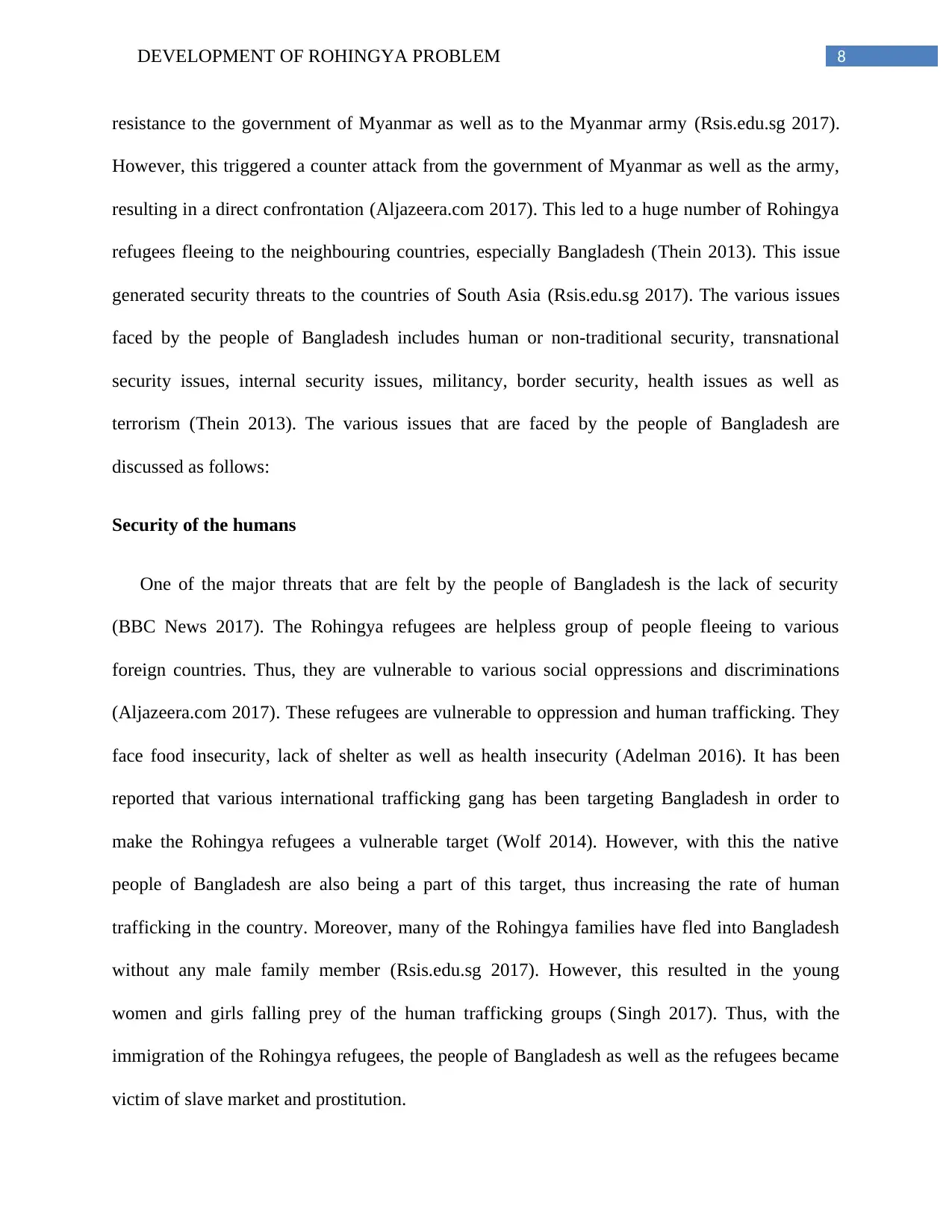
8DEVELOPMENT OF ROHINGYA PROBLEM
resistance to the government of Myanmar as well as to the Myanmar army (Rsis.edu.sg 2017).
However, this triggered a counter attack from the government of Myanmar as well as the army,
resulting in a direct confrontation (Aljazeera.com 2017). This led to a huge number of Rohingya
refugees fleeing to the neighbouring countries, especially Bangladesh (Thein 2013). This issue
generated security threats to the countries of South Asia (Rsis.edu.sg 2017). The various issues
faced by the people of Bangladesh includes human or non-traditional security, transnational
security issues, internal security issues, militancy, border security, health issues as well as
terrorism (Thein 2013). The various issues that are faced by the people of Bangladesh are
discussed as follows:
Security of the humans
One of the major threats that are felt by the people of Bangladesh is the lack of security
(BBC News 2017). The Rohingya refugees are helpless group of people fleeing to various
foreign countries. Thus, they are vulnerable to various social oppressions and discriminations
(Aljazeera.com 2017). These refugees are vulnerable to oppression and human trafficking. They
face food insecurity, lack of shelter as well as health insecurity (Adelman 2016). It has been
reported that various international trafficking gang has been targeting Bangladesh in order to
make the Rohingya refugees a vulnerable target (Wolf 2014). However, with this the native
people of Bangladesh are also being a part of this target, thus increasing the rate of human
trafficking in the country. Moreover, many of the Rohingya families have fled into Bangladesh
without any male family member (Rsis.edu.sg 2017). However, this resulted in the young
women and girls falling prey of the human trafficking groups (Singh 2017). Thus, with the
immigration of the Rohingya refugees, the people of Bangladesh as well as the refugees became
victim of slave market and prostitution.
resistance to the government of Myanmar as well as to the Myanmar army (Rsis.edu.sg 2017).
However, this triggered a counter attack from the government of Myanmar as well as the army,
resulting in a direct confrontation (Aljazeera.com 2017). This led to a huge number of Rohingya
refugees fleeing to the neighbouring countries, especially Bangladesh (Thein 2013). This issue
generated security threats to the countries of South Asia (Rsis.edu.sg 2017). The various issues
faced by the people of Bangladesh includes human or non-traditional security, transnational
security issues, internal security issues, militancy, border security, health issues as well as
terrorism (Thein 2013). The various issues that are faced by the people of Bangladesh are
discussed as follows:
Security of the humans
One of the major threats that are felt by the people of Bangladesh is the lack of security
(BBC News 2017). The Rohingya refugees are helpless group of people fleeing to various
foreign countries. Thus, they are vulnerable to various social oppressions and discriminations
(Aljazeera.com 2017). These refugees are vulnerable to oppression and human trafficking. They
face food insecurity, lack of shelter as well as health insecurity (Adelman 2016). It has been
reported that various international trafficking gang has been targeting Bangladesh in order to
make the Rohingya refugees a vulnerable target (Wolf 2014). However, with this the native
people of Bangladesh are also being a part of this target, thus increasing the rate of human
trafficking in the country. Moreover, many of the Rohingya families have fled into Bangladesh
without any male family member (Rsis.edu.sg 2017). However, this resulted in the young
women and girls falling prey of the human trafficking groups (Singh 2017). Thus, with the
immigration of the Rohingya refugees, the people of Bangladesh as well as the refugees became
victim of slave market and prostitution.
⊘ This is a preview!⊘
Do you want full access?
Subscribe today to unlock all pages.

Trusted by 1+ million students worldwide
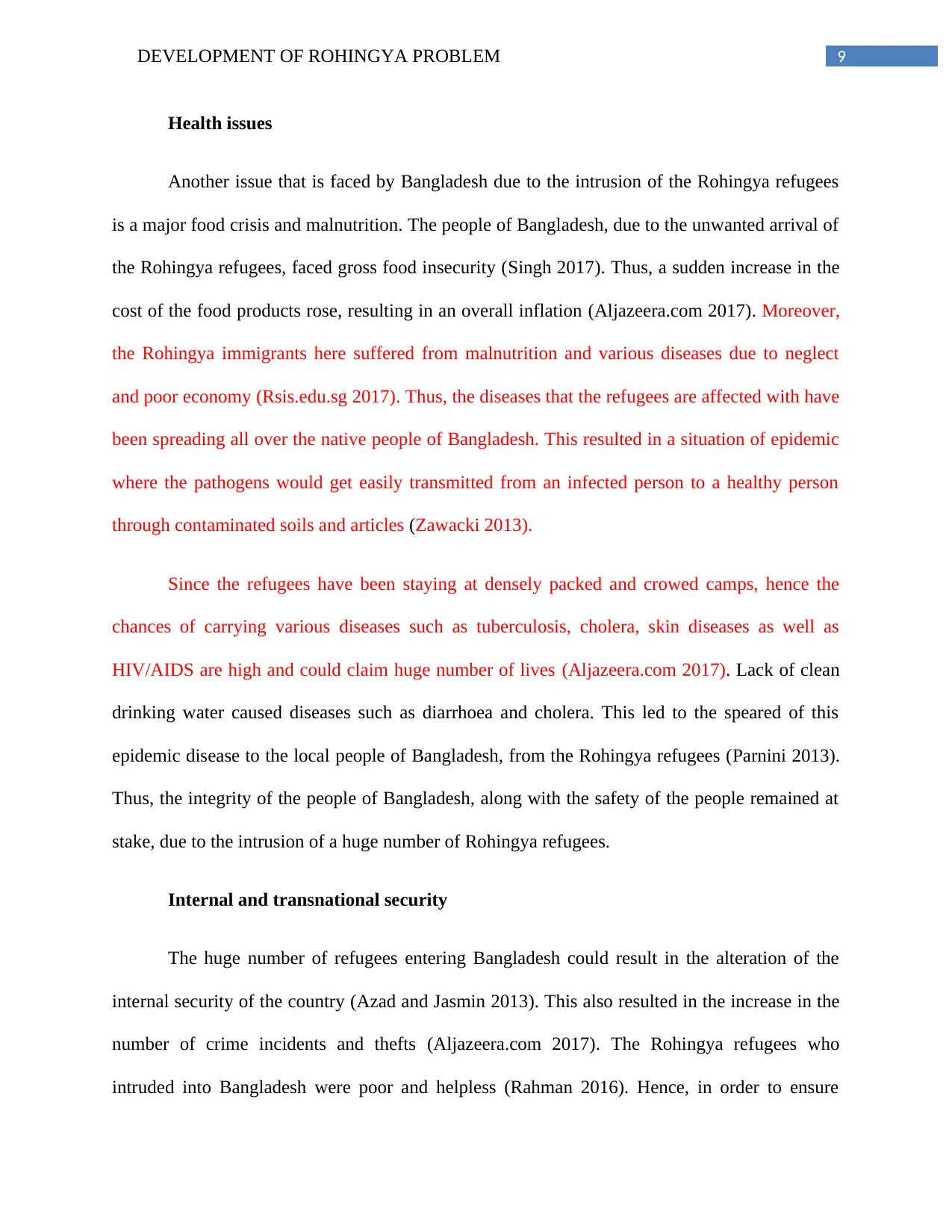
9DEVELOPMENT OF ROHINGYA PROBLEM
Health issues
Another issue that is faced by Bangladesh due to the intrusion of the Rohingya refugees
is a major food crisis and malnutrition. The people of Bangladesh, due to the unwanted arrival of
the Rohingya refugees, faced gross food insecurity (Singh 2017). Thus, a sudden increase in the
cost of the food products rose, resulting in an overall inflation (Aljazeera.com 2017). Moreover,
the Rohingya immigrants here suffered from malnutrition and various diseases due to neglect
and poor economy (Rsis.edu.sg 2017). Thus, the diseases that the refugees are affected with have
been spreading all over the native people of Bangladesh. This resulted in a situation of epidemic
where the pathogens would get easily transmitted from an infected person to a healthy person
through contaminated soils and articles (Zawacki 2013).
Since the refugees have been staying at densely packed and crowed camps, hence the
chances of carrying various diseases such as tuberculosis, cholera, skin diseases as well as
HIV/AIDS are high and could claim huge number of lives (Aljazeera.com 2017). Lack of clean
drinking water caused diseases such as diarrhoea and cholera. This led to the speared of this
epidemic disease to the local people of Bangladesh, from the Rohingya refugees (Parnini 2013).
Thus, the integrity of the people of Bangladesh, along with the safety of the people remained at
stake, due to the intrusion of a huge number of Rohingya refugees.
Internal and transnational security
The huge number of refugees entering Bangladesh could result in the alteration of the
internal security of the country (Azad and Jasmin 2013). This also resulted in the increase in the
number of crime incidents and thefts (Aljazeera.com 2017). The Rohingya refugees who
intruded into Bangladesh were poor and helpless (Rahman 2016). Hence, in order to ensure
Health issues
Another issue that is faced by Bangladesh due to the intrusion of the Rohingya refugees
is a major food crisis and malnutrition. The people of Bangladesh, due to the unwanted arrival of
the Rohingya refugees, faced gross food insecurity (Singh 2017). Thus, a sudden increase in the
cost of the food products rose, resulting in an overall inflation (Aljazeera.com 2017). Moreover,
the Rohingya immigrants here suffered from malnutrition and various diseases due to neglect
and poor economy (Rsis.edu.sg 2017). Thus, the diseases that the refugees are affected with have
been spreading all over the native people of Bangladesh. This resulted in a situation of epidemic
where the pathogens would get easily transmitted from an infected person to a healthy person
through contaminated soils and articles (Zawacki 2013).
Since the refugees have been staying at densely packed and crowed camps, hence the
chances of carrying various diseases such as tuberculosis, cholera, skin diseases as well as
HIV/AIDS are high and could claim huge number of lives (Aljazeera.com 2017). Lack of clean
drinking water caused diseases such as diarrhoea and cholera. This led to the speared of this
epidemic disease to the local people of Bangladesh, from the Rohingya refugees (Parnini 2013).
Thus, the integrity of the people of Bangladesh, along with the safety of the people remained at
stake, due to the intrusion of a huge number of Rohingya refugees.
Internal and transnational security
The huge number of refugees entering Bangladesh could result in the alteration of the
internal security of the country (Azad and Jasmin 2013). This also resulted in the increase in the
number of crime incidents and thefts (Aljazeera.com 2017). The Rohingya refugees who
intruded into Bangladesh were poor and helpless (Rahman 2016). Hence, in order to ensure
Paraphrase This Document
Need a fresh take? Get an instant paraphrase of this document with our AI Paraphraser
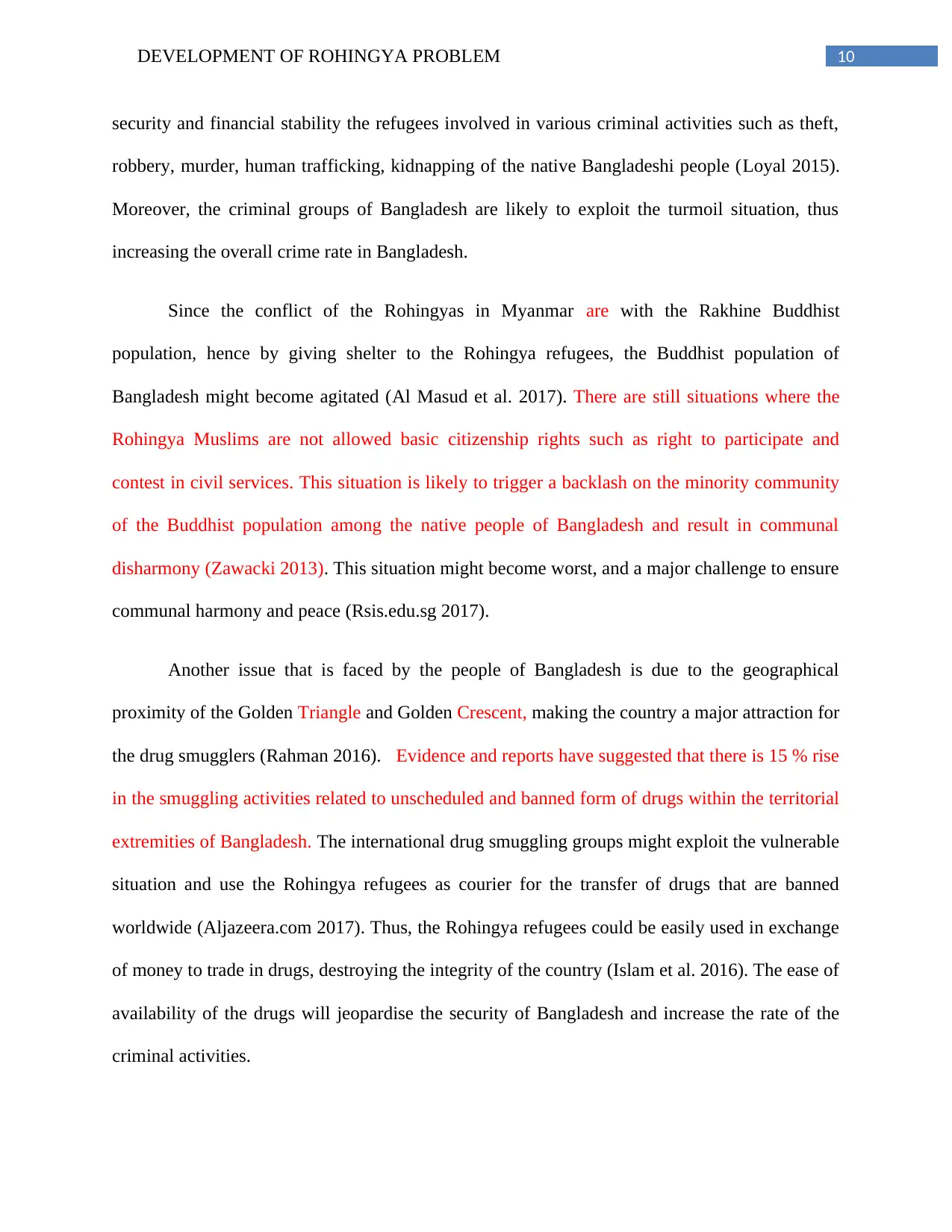
10DEVELOPMENT OF ROHINGYA PROBLEM
security and financial stability the refugees involved in various criminal activities such as theft,
robbery, murder, human trafficking, kidnapping of the native Bangladeshi people (Loyal 2015).
Moreover, the criminal groups of Bangladesh are likely to exploit the turmoil situation, thus
increasing the overall crime rate in Bangladesh.
Since the conflict of the Rohingyas in Myanmar are with the Rakhine Buddhist
population, hence by giving shelter to the Rohingya refugees, the Buddhist population of
Bangladesh might become agitated (Al Masud et al. 2017). There are still situations where the
Rohingya Muslims are not allowed basic citizenship rights such as right to participate and
contest in civil services. This situation is likely to trigger a backlash on the minority community
of the Buddhist population among the native people of Bangladesh and result in communal
disharmony (Zawacki 2013). This situation might become worst, and a major challenge to ensure
communal harmony and peace (Rsis.edu.sg 2017).
Another issue that is faced by the people of Bangladesh is due to the geographical
proximity of the Golden Triangle and Golden Crescent, making the country a major attraction for
the drug smugglers (Rahman 2016). Evidence and reports have suggested that there is 15 % rise
in the smuggling activities related to unscheduled and banned form of drugs within the territorial
extremities of Bangladesh. The international drug smuggling groups might exploit the vulnerable
situation and use the Rohingya refugees as courier for the transfer of drugs that are banned
worldwide (Aljazeera.com 2017). Thus, the Rohingya refugees could be easily used in exchange
of money to trade in drugs, destroying the integrity of the country (Islam et al. 2016). The ease of
availability of the drugs will jeopardise the security of Bangladesh and increase the rate of the
criminal activities.
security and financial stability the refugees involved in various criminal activities such as theft,
robbery, murder, human trafficking, kidnapping of the native Bangladeshi people (Loyal 2015).
Moreover, the criminal groups of Bangladesh are likely to exploit the turmoil situation, thus
increasing the overall crime rate in Bangladesh.
Since the conflict of the Rohingyas in Myanmar are with the Rakhine Buddhist
population, hence by giving shelter to the Rohingya refugees, the Buddhist population of
Bangladesh might become agitated (Al Masud et al. 2017). There are still situations where the
Rohingya Muslims are not allowed basic citizenship rights such as right to participate and
contest in civil services. This situation is likely to trigger a backlash on the minority community
of the Buddhist population among the native people of Bangladesh and result in communal
disharmony (Zawacki 2013). This situation might become worst, and a major challenge to ensure
communal harmony and peace (Rsis.edu.sg 2017).
Another issue that is faced by the people of Bangladesh is due to the geographical
proximity of the Golden Triangle and Golden Crescent, making the country a major attraction for
the drug smugglers (Rahman 2016). Evidence and reports have suggested that there is 15 % rise
in the smuggling activities related to unscheduled and banned form of drugs within the territorial
extremities of Bangladesh. The international drug smuggling groups might exploit the vulnerable
situation and use the Rohingya refugees as courier for the transfer of drugs that are banned
worldwide (Aljazeera.com 2017). Thus, the Rohingya refugees could be easily used in exchange
of money to trade in drugs, destroying the integrity of the country (Islam et al. 2016). The ease of
availability of the drugs will jeopardise the security of Bangladesh and increase the rate of the
criminal activities.
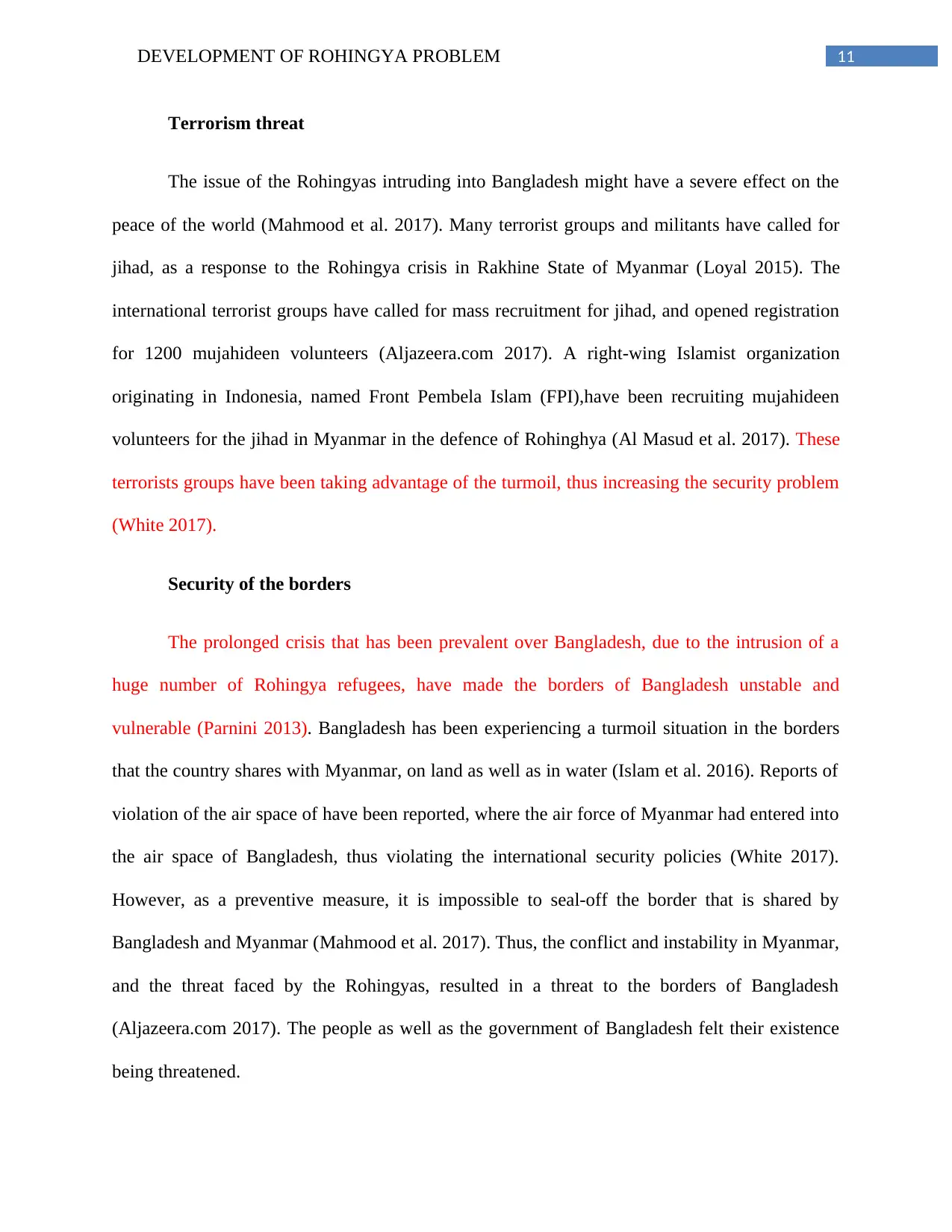
11DEVELOPMENT OF ROHINGYA PROBLEM
Terrorism threat
The issue of the Rohingyas intruding into Bangladesh might have a severe effect on the
peace of the world (Mahmood et al. 2017). Many terrorist groups and militants have called for
jihad, as a response to the Rohingya crisis in Rakhine State of Myanmar (Loyal 2015). The
international terrorist groups have called for mass recruitment for jihad, and opened registration
for 1200 mujahideen volunteers (Aljazeera.com 2017). A right-wing Islamist organization
originating in Indonesia, named Front Pembela Islam (FPI),have been recruiting mujahideen
volunteers for the jihad in Myanmar in the defence of Rohinghya (Al Masud et al. 2017). These
terrorists groups have been taking advantage of the turmoil, thus increasing the security problem
(White 2017).
Security of the borders
The prolonged crisis that has been prevalent over Bangladesh, due to the intrusion of a
huge number of Rohingya refugees, have made the borders of Bangladesh unstable and
vulnerable (Parnini 2013). Bangladesh has been experiencing a turmoil situation in the borders
that the country shares with Myanmar, on land as well as in water (Islam et al. 2016). Reports of
violation of the air space of have been reported, where the air force of Myanmar had entered into
the air space of Bangladesh, thus violating the international security policies (White 2017).
However, as a preventive measure, it is impossible to seal-off the border that is shared by
Bangladesh and Myanmar (Mahmood et al. 2017). Thus, the conflict and instability in Myanmar,
and the threat faced by the Rohingyas, resulted in a threat to the borders of Bangladesh
(Aljazeera.com 2017). The people as well as the government of Bangladesh felt their existence
being threatened.
Terrorism threat
The issue of the Rohingyas intruding into Bangladesh might have a severe effect on the
peace of the world (Mahmood et al. 2017). Many terrorist groups and militants have called for
jihad, as a response to the Rohingya crisis in Rakhine State of Myanmar (Loyal 2015). The
international terrorist groups have called for mass recruitment for jihad, and opened registration
for 1200 mujahideen volunteers (Aljazeera.com 2017). A right-wing Islamist organization
originating in Indonesia, named Front Pembela Islam (FPI),have been recruiting mujahideen
volunteers for the jihad in Myanmar in the defence of Rohinghya (Al Masud et al. 2017). These
terrorists groups have been taking advantage of the turmoil, thus increasing the security problem
(White 2017).
Security of the borders
The prolonged crisis that has been prevalent over Bangladesh, due to the intrusion of a
huge number of Rohingya refugees, have made the borders of Bangladesh unstable and
vulnerable (Parnini 2013). Bangladesh has been experiencing a turmoil situation in the borders
that the country shares with Myanmar, on land as well as in water (Islam et al. 2016). Reports of
violation of the air space of have been reported, where the air force of Myanmar had entered into
the air space of Bangladesh, thus violating the international security policies (White 2017).
However, as a preventive measure, it is impossible to seal-off the border that is shared by
Bangladesh and Myanmar (Mahmood et al. 2017). Thus, the conflict and instability in Myanmar,
and the threat faced by the Rohingyas, resulted in a threat to the borders of Bangladesh
(Aljazeera.com 2017). The people as well as the government of Bangladesh felt their existence
being threatened.
⊘ This is a preview!⊘
Do you want full access?
Subscribe today to unlock all pages.

Trusted by 1+ million students worldwide
1 out of 30
Your All-in-One AI-Powered Toolkit for Academic Success.
+13062052269
info@desklib.com
Available 24*7 on WhatsApp / Email
![[object Object]](/_next/static/media/star-bottom.7253800d.svg)
Unlock your academic potential
Copyright © 2020–2025 A2Z Services. All Rights Reserved. Developed and managed by ZUCOL.
